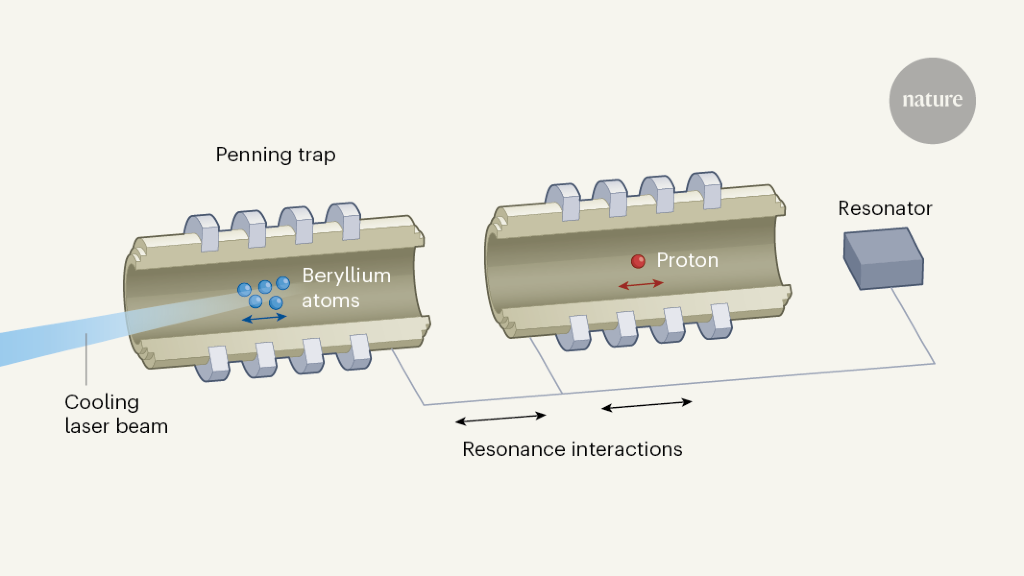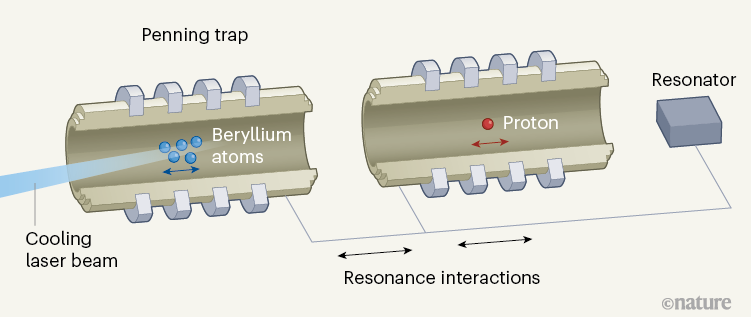In a paper in Nature, Bohman et al.1 (the BASE Collaboration) report the cooling of a single proton by a cloud of laser-cooled beryllium ions. Remarkably, the ions were separated from the proton by a distance of about 9 centimetres — which is too far apart for the charges on the ions to have interacted with that of the proton. This means that the ions could not have exerted a direct cooling effect on the proton. Instead, the researchers used an indirect cooling process, mediated by an electric circuit that established an effective interaction. This approach has potential applications in studies of antimatter particles and in the field of quantum information.
A wealth of knowledge about nature’s inner workings comes from studies of fundamental particles, such as electrons and protons. Currently, the most accurate theoretical model of the forces of nature is the standard model of particle physics, which describes how fundamental particles interact with each other and thereby build up the macroscopic world. The standard model has passed many stringent tests using various experimental tools, at particle energies that range from 1011 electronvolts in particle accelerators2 to only about 0.0001 electronvolts in ion traps3. However, it is widely accepted that the standard model does not explain some natural phenomena, such as the fact that the Universe is made up of only matter. It also does not account for the existence of dark matter — the invisible and largely unaccounted for mass of the Universe.
High-precision measurements of fundamental particles and their corresponding antiparticles provide opportunities to verify the standard model, and maybe even to find evidence of new physics that goes beyond the currently accepted model4,5. Two conditions must be met to perform such measurements: the particles must be spatially confined; and they should be very nearly at rest (that is, the particles must be cooled to almost zero kelvin, to minimize their kinetic energy). The first of these requirements can be solved using a combination of static electric and magnetic fields in a device called a Penning trap.
Laser-cooling methods were first reported6,7 in 1975, and have since been widely developed to reduce the motion of particles. This approach works well for atoms, but not for particles that do not absorb light, such as protons. Scientists have therefore invented other cooling methods, such as resistive cooling8 (in which ions dissipate their energy by inducing a current in a cold electric circuit) and synchrotron cooling9 (in which fast-rotating particles with low mass radiate energy by emitting electromagnetic radiation). However, the lowest particle temperatures achieved using those approaches are roughly 1,000 to one million times higher than those of laser-cooled atoms.
An interesting alternative is to cool a charged particle by bringing it close to another, colder charged particle10 — an approach commonly known as sympathetic cooling. For example, consider a positively charged atomic ion that is being continuously laser-cooled to one-thousandth of a kelvin, and which is then brought close to a proton that is initially at 4 K in an ion trap. The proton and ion will repel each other within the confinement of the ion trap, effectively transferring kinetic energy from the proton to the ion. Because the ion is constantly being laser-cooled, the repulsive interactions will eventually chill the proton to the same temperature as the ion, even though the proton is not being cooled directly.
Sympathetic cooling works well, but the nearby presence of an ion would be undesirable when making ultraprecise measurements of a proton’s properties. Furthermore, the method requires that the particle and the ion have charges of the same polarity, to provide the necessary repulsive interactions. Bohman and colleagues’ work provides a potential solution to these issues.
The authors used separate Penning traps to confine a cloud of beryllium ions and a proton in an ultrahigh vacuum, and continuously laser-cooled the ions (Fig. 1). The proton and the ions were then set up to ‘talk’ to an electrical resonator circuit, which enables the two trapped-particle systems to interact only when the natural oscillation frequencies (the resonance frequencies) of the two systems match exactly. Bohman et al. demonstrated the influence of the ions on the proton using an established technique, in which electrical ‘noise’ in the resonator circuit is analysed to directly determine the temperatures of the two systems.
To further ensure that the proton cooling is indeed caused by the ions, the authors fixed the oscillation frequency of the proton, and then varied the oscillation frequency of the ions. They observed that cooling interactions occurred only when the ions’ natural oscillation frequency matched that of both the proton and the resonator circuit, as expected. Furthermore, the researchers found that numerical simulations of the cooling set-up matched the observed experimental result, confirming the ions’ proton-cooling influence.
Impressively, Bohman et al. show that the proton temperature can be reduced by 85%, which would be a substantial amount in an ultraprecise measurement of a fundamental particle. The authors’ technique opens up the possibility of being able to cool any charged particle by ‘wiring it up’ to laser-cooled ions, with any distance between the particle and the ions.
The results also have implications for research in quantum information. A goal for this field is to exchange single bits of quantum information between spatially separated quantum systems. However, it is challenging to do this using a conducting wire. Bohman and colleagues’ findings suggest a possible solution to this problem, but it will first be necessary to broaden our understanding of how single quanta of energy are exchanged over large distances, and to greatly improve the rate of energy exchange between the separated systems.
Competing Interests
The author declares no competing interests.





More News
Author Correction: Bitter taste receptor activation by cholesterol and an intracellular tastant – Nature
Audio long read: How does ChatGPT ‘think’? Psychology and neuroscience crack open AI large language models
Ozempic keeps wowing: trial data show benefits for kidney disease